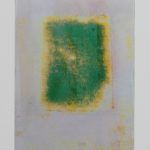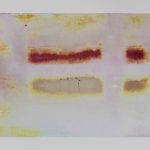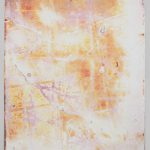For his 4th Solo exhibition at Galeria Leme, Richard Galpin presents an exciting new body of work consisting of ‘orbital sanded photographs’. The works are standard photographic prints sanded back with the use of an electric sander – the type of hand-held power tool used by car body shops and interior decorators.
These works display loose diffuse fields of color – a surprising new aesthetic for the artist whose works to date have been characterized by sharp precision and linear geometry. While the visual language is reminiscent of American Abstract Expressionism or Color Field painting, Galpin follows a similar methodology as in his previous work. Starting with prints of his own medium-format photographs of the city, the artist isolates blocks of color with the edge of the sanding tool, selectively erasing any legible detail that would give an indication of scale or location. The orbital action of the sander diffuses the paper’s dyes to mix new colors from the dust of the print. Color is a key concern of the work as the artist explains:
“Over the last 12 years of working with photographs of cities I have built a strong sense of the color palette of the cities I know well. On previously trips to Sao Paulo I had recorded muted sun-bleached tones of creams, ochres, pale yellows, and dusky brown-reds. On my most recent visit to Sao Paulo I was surprised to see a proliferation of intense and vibrant hues on the city’s many rendered surfaces – acid greens, fresh pinks, saturated blues…
When I asked about this, someone suggested it was due to a deal struck between the city municipality and a large paint manufacturer to offer up free paint for the renovation of buildings – on condition that the paint supplied was in the brightest of colors. At the time I took this at face value (it was reminiscent of Lei Cidade Limpa – (the law of the clean city) passed in 2006 to ban all external advertising – a ruling which had the unintended consequence of leaving skeletal steel frameworks haunting the skyline). However subsequent research has been unable to uncover any official planning strategy relating to color – it seems to have been no more than a misunderstanding, or a false rumor. Were the residents and business owners of Sao Paulo’s fashionable and wealthy neighborhoods – Jardins and Vila Madalena – spontaneously and simultaneously developing a new high-impact color palette? Does it relate more broadly to the mood or ambition of the city?
I’m still amused by the idea of a municipal color agency. I imagine a department of the municipal government tasked with selecting the color palette, with careful consideration of each color swatch to have the appropriate aspirations for the new Sao Paulo…
The fictional municipal color agency that the artist imagines has echoes of the real life examples of the use of color in the built environment such as Haas & Hahn’s work with local youths in the Santa Marta favela in Rio, or Edi Rama’s period as mayor of Tirana, Albania from 2000 – 2011 where the bold use of color on buildings was part of a broader transformation of the city. It also emerges out of the artist’s interest in commercial paint color charts and their embedded history of taste and aspiration. These color charts change over time, and paradoxically aim to both respond to and lead the creation of taste, fashion and identity. (See for example the color company Pantone’s announcements for its ‘Color of the Year’, claiming to both channel the zeitgeist, and be a world leader in the development of fashion and taste.
In the urban environment the renewal of paintwork and the evolution of color is part of the broader processes of urban change and is renewal that Richard Galpin’s work is concerned with.
Also presented in the exhibition, is a body of smaller works under the series title “Dissolution” made with the same sanding technique, but with an all-over sanding technique, which renders a more diffuse image, with fewer remaining blocks of color. These delicate works, which relate more to drawing or printmaking, contain finer more obscure traces of the past image, as well as holes in the paper and imprints where the underlying surface of the artist’s studio table or wall has inscribed itself into the image.
About the artist:
Richard Galpin (Cambridgeshire, England, 1975). Lives and works in London, England, UK
Amongst his solo exhibitions stand out: “Let us build a city and a tower”, Hales Galley, London, England, UK (2011); “DIVISION” Galeria Leme, São Paulo, Brazil (2010); “Viewing Station”, High Line, New York, USA (public commission) (2010). And the group shows: “Intersection: Photography / Painting / Document”, Marlborough Gallery, New York, USA (2011); “Moving maps”, Rolex Learning Centre, EPLF, Lausanne, Switzerland (2011); “Photography gallery collection, Victoria and Albert Museum, London, England, UK (2010) and “Uncertain Terrain, Knoxville Museum of Art, Tennessee, USA (2010). His works are in collections such as: The British Museum, Victoria and Albert Museum and Deutsche Bank.













